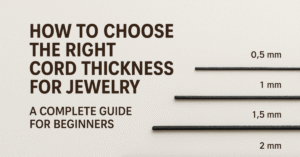When it comes to creating beautiful jewelry, choosing how to choose right cord thickness for jwelry is as important as selecting the beads or charms. Whether you’re designing a boho bracelet, an elegant necklace, or a simple anklet the cord plays a huge role in the durability, comfort, and overall look of your piece.
In 2025, jewelry makers are moving toward sustainable materials and handmade crafts. Therefore, knowing how to choose right thickness for jewelry ensures your designs not only look professional but also last longer.
In this guide, we’ll explore how to choose the correct cord size, understand different cord materials, and find the right match for your jewelry style.

Step 1: Understand the Basics of Cord Thickness
Before choosing the right cord, you must understand what cord thickness actually means.
Cord thickness is measured in millimeters (mm) and directly affects how your jewelry looks and feels. Thinner cords create a delicate and minimalist design, while thicker cords give a bold, rustic, or statement appeal.
| Cord Type | Typical Thickness | Best Use |
|---|---|---|
| Fine (0.3mm – 0.8mm) | Dainty jewelry, seed beads, minimalist styles | |
| Medium (1mm – 2mm) | General bracelets, necklaces, pendants | |
| Thick (2mm – 4mm) | Statement jewelry, macramé, leather crafts | |
| Extra Thick (5mm+) | Fashion chokers, layered cords, rope-style jewelry |
Therefore, the cord thickness you select should balance both aesthetic appeal and structural strength.
Step 2: Match Cord Thickness with Jewelry Type
Every jewelry style has its own cord requirement. Choosing the wrong one can make your piece too stiff, too loose, or even impossible to assemble.
1. For Beaded Bracelets
If your design includes beads, the cord must fit through the bead holes. Most bead holes range from 0.5mm to 2mm, so cords between 0.5mm and 1.5mm are ideal.
-
Use waxed cotton cord or nylon thread for flexibility.
-
For heavier beads like glass or metal, go for a 1mm+ cord for durability.
2. For Necklaces
Necklaces require strength and smoothness to sit comfortably on the neck.
-
Choose 1.5mm – 2mm cords for pendants or charm necklaces.
-
For layered or rope designs, 2mm – 3mm leather cords offer an elegant look.
3. For Macramé Jewelry
Macramé jewelry is all about knots and patterns.
-
Use 1mm – 3mm cords depending on the intricacy.
-
Thicker cords (3mm+) create bold knots suitable for boho or beach styles.
4. For Anklets and Chokers
These pieces face more wear and tear, so choose durable cords between 1.5mm and 2.5mm.
-
Leather, satin, or braided nylon cords are popular choices for strength and comfort.
Step 3: Consider the Cord Material
The material of the cord affects not only thickness but also the flexibility, texture, and durability.
Here are popular cord types used in jewelry making:
Leather Cord
-
Best for: Bracelets, necklaces, chokers
-
Thickness Range: 1mm – 4mm
-
Advantages: Natural look, durable, and comfortable on skin
-
Tip: Choose genuine leather for quality or faux leather for vegan options.
Waxed Cotton Cord
-
Best for: Beaded bracelets, macramé, friendship jewelry
-
Thickness Range: 0.5mm – 2mm
-
Advantages: Smooth, easy to knot, affordable, available in many colors
Nylon Cord
-
Best for: Knotting, beaded necklaces, and adjustable jewelry
-
Thickness Range: 0.3mm – 2mm
-
Advantages: Stretchable, strong, and resistant to fraying
Silk Cord
-
Best for: Fine jewelry, pearls, and luxury designs
-
Thickness Range: 0.3mm – 1mm
-
Advantages: Elegant texture, flexible, ideal for stringing pearls
Elastic Cord
-
Best for: Stretch bracelets and easy-wear jewelry
-
Thickness Range: 0.5mm – 1mm
-
Advantages: Stretchable, convenient, but less durable over time
Step 4: Choose Cord Thickness Based on Bead Hole Size
A common beginner mistake is selecting a cord that doesn’t fit through the beads.
How to Measure Bead Hole Size:
-
Use a digital caliper or a needle gauge to measure hole diameter.
-
The cord should be slightly thinner than the bead hole, allowing smooth threading.
Example:
If bead hole size = 2mm, choose a 1.5mm cord to ensure smooth movement and flexibility.
Furthermore, if your design includes multiple passes (threading the cord through the same bead more than once), choose a thinner cord (around 0.8mm–1mm).
Step 5: Test Before Finalizing
Before finalizing your design, it’s smart to test different cord thicknesses.
-
Create a small sample bracelet or necklace.
-
Check if the cord holds knots firmly and fits the beads properly.
-
Try wearing the sample to test comfort and flexibility.
This small step ensures your final jewelry looks professional and lasts longer.
Step 6: Balancing Aesthetics and Functionality
A beautiful design must also be functional. Therefore, consider the following:
-
For Minimal Designs: 0.5mm – 1mm cords give a clean, delicate look.
-
For Statement Pieces: 2mm – 3mm cords add volume and boldness.
-
For Layered Jewelry: Combine cords of different thicknesses for contrast.
Always tailor the cord thickness to your design theme — whether elegant, casual, or bohemian.
Step 7: Know Your Tools and Techniques
Your choice of tools and finishing methods also affects which cord works best.
-
Use cord ends, crimps, or glue for thicker cords like leather.
-
For fine cords like silk or nylon, knotting or beading needles are essential.
-
If using multiple strands, make sure your clasps can handle the total thickness.
This attention to detail ensures your jewelry feels secure and high-quality.
Bonus Tip: Common Cord Thickness Mistakes to Avoid
-
Choosing a cord thicker than the bead hole.
-
Ignoring cord stretch — especially with elastic or nylon.
-
Over-tightening knots that can damage thin cords.
-
Using too-thin cords for heavy pendants.
-
Forgetting to seal cord ends to prevent fraying.
Avoiding these ensures your jewelry maintains both beauty and durability.
In Conclusion
How to Choose right cord thickness for jewelry is a mix of creativity and technique. From measuring bead holes to matching materials with style, every detail matters.
Therefore, before starting your next bracelet or necklace project:
-
Identify your jewelry type.
-
Match the bead hole size.
-
Select the right material and thickness.
-
Test for comfort and strength.
By following these simple steps, you’ll create stunning, professional-quality jewelry that feels as good as it looks.
FAQs
Q1. What is the best cord thickness for beaded bracelets?
→ Usually between 0.5mm and 1mm, depending on bead size.
Q2. Can I use leather cords for necklaces?
→ Yes, leather cords (1.5mm–3mm) are perfect for pendants and statement necklaces.
Q3. How can I prevent cord fraying?
→ Seal the ends with glue or use crimp beads to secure them.
Q4. Is thicker cord always stronger?
→ Not always — strength also depends on the material. Nylon cords, for example, are strong even in thinner sizes.
Q5. What cord size is best for beginners?
→ Start with 1mm waxed cotton or nylon cords — they’re flexible, affordable, and easy to handle.
